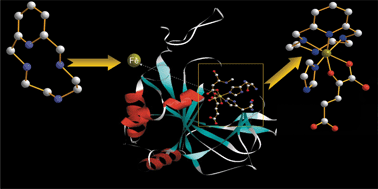Evidence for inhibition of HIF-1α prolyl hydroxylase 3 activity by four biologically active tetraazamacrocycles†
Abstract
Hypoxia inducible factor 1 (HIF-1) is central to the hypoxic response in mammals. HIF-1α

* Corresponding authors
a
State Key Laboratory of Coordination Chemistry, School of Chemistry and Chemical Engineering, Nanjing University, Nanjing 210093, P. R. China
E-mail:
wangzl@nju.edu.cn
Fax: +86-25-83317761
Tel: +86-25-83686082
Hypoxia inducible factor 1 (HIF-1) is central to the hypoxic response in mammals. HIF-1α

 Please wait while we load your content...
Something went wrong. Try again?
Please wait while we load your content...
Something went wrong. Try again?
J. Cao, Z. Geng, X. Ma, J. Wen, Y. Yin and Z. Wang, Org. Biomol. Chem., 2012, 10, 3913 DOI: 10.1039/C2OB07076F
To request permission to reproduce material from this article, please go to the Copyright Clearance Center request page.
If you are an author contributing to an RSC publication, you do not need to request permission provided correct acknowledgement is given.
If you are the author of this article, you do not need to request permission to reproduce figures and diagrams provided correct acknowledgement is given. If you want to reproduce the whole article in a third-party publication (excluding your thesis/dissertation for which permission is not required) please go to the Copyright Clearance Center request page.
Read more about how to correctly acknowledge RSC content.
 Fetching data from CrossRef.
Fetching data from CrossRef.
This may take some time to load.
Loading related content
